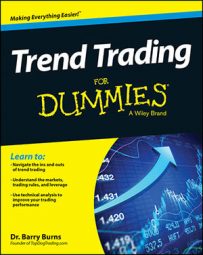Trading to the long side or going long simply refers to buying the market first and then selling your market position later. The idea is to buy at a low price (relatively inexpensive price) and sell at a higher price to make a profit. In other words, “buy low, sell high.”
Most businesses trade to the long side. A business buys its products at wholesale, sells them to their customers at retail, and makes a profit on the spread.
![[Credit: Figure by Barry Burns]](https://www.dummies.com/wp-content/uploads/448325.image0.jpg)
The terms buy and going long aren’t quite synonymous. Going long refers to taking a position where you take ownership of the stock because you’re buying first and selling later. Buying a stock and going long are interchangeable if you buy the stock first. However, the term buy is a broader term than going long because it can also refer to buying a position that you’ve first shorted.
The advantages of going long
Trading to the long side (buying an uptrend) is congruent with how most people think of trading and investing. Buying first and then selling later (hopefully at a higher price) has several advantages:
It’s the order of most commerce and therefore is comfortable. You don’t have to overcome any psychological struggle with this concept.
Going long is less expensive than going short. When you short a stock, you’re borrowing the stock and have to pay a fee for doing so.
Buying has limited risk. The farthest the market you buy can go down is to zero. Be aware that trading with leverage can increase that risk.
Buying into the market, especially stocks, provides support for the company to thrive. This is purely a matter of conscience that may or may not apply to you. Some people don't feel right betting against the economy or any business.
Your profits theoretically have no limit because there’s no price restriction on how high the market can go up. This is in direct contradiction to short selling where your losses have no theoretical limit because there’s no restriction to how high the market can go.
The trend of the stock market over its history has been to the upside. Therefore, buying the market puts the long-term trend of the stock market on your side.
The disadvantages of trading to the long side
Although trading to the long side has many advantages and is the way most companies do business, it also has some disadvantages, such as the following:
Markets tend to go up slower than they go down, so trading long is a slower way to make money. Although the markets can definitely make dramatic moves to the upside at times, in general, markets fall faster than they rise.
If you trade only to the long side, you severely limit your ability to make money as a trader. You won’t be able to take advantage of downtrends and will have long periods when you won’t be making money, which is opportunity lost.

